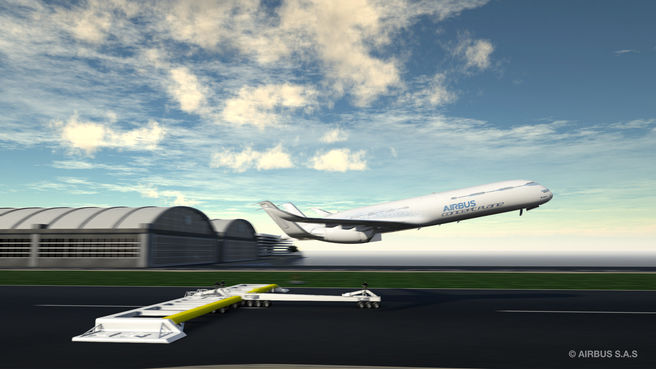Yes there would be fuel savings, from multiple sources:
- Efficiency gain from the ground based launcher.
- Weight saving from smaller engine size.
Efficiency gain. According to this site, a B747 uses 5,700 lbs for the take-off, out of 422,000 lbs max. fuel. That is 1.35% of fuel for a long range airliner, percentage for a shorter range airliner would be higher. The catapult or electric tow line would now have to deliver the take-off energy - if powered by electricity, the efficiency is much higher. A factor of over 2 is gained from not accelerating air but the aircraft itself, and combined cycle power is much more efficient than a single gas turbine. From wikipedia:
By combining these multiple streams of work upon a single mechanical shaft turning an electric generator, the overall net efficiency of the system may be increased by 50–60%. That is, from an overall efficiency of say 34% (in a single cycle) to possibly an overall efficiency of 62.22% (in a mechanical combination of two cycles) in net Carnot thermodynamic efficiency. This can be done because heat engines are only able to use a portion of the energy their fuel generates (usually less than 50%). In an ordinary (non combined cycle) heat engine the remaining heat (e.g., hot exhaust fumes) from combustion is generally wasted.
So in an aeroplane, air is accelerated by a thermodynamic process with 35% efficiency. When launched by a catapult, the aircraft is accelerated from a thermodynamic process with over 60% efficiency. Total efficiency gain is the factor 2 reported above, times 60/35 = 3.4 times higher. Leading to 5,700/3.4 = 1,700 lbs required for catapult launch take-off. A potential saving of 4,000 lbs at every take-off of a B747. Of course, a lot of this is negated by having the engines running at RPMs that allow for a climb right after take-off, but even a saving of 1,000 lbs/heavy aeroplane would provide an incredible yearly saving at a busy airport like O'Hare.
Weight savings. Airbus is making a case for this (now behind an authorisation wall). Maximum thrust is only used at take-off, an assisted take-off would mean lighter engines with associated lower fuel burn. From the article:
Listen to the changing sound of engines during flight and it’s obvious: an aircraft draws on its power reserves more during takeoff than at any other time. The power needed to take off is determined based on a number of factors - including runway length, wind speed, temperature, and the weight of the aircraft itself.
However, this takeoff power only is required for a very brief portion of the total flight. Once cruising in the sky overhead, an aircraft doesn’t need as much to maintain altitude. So why not source the energy required at takeoff from an innovation installed on the ground? Can the burden (and weight) be removed from the aircraft itself?
An assisted takeoff – using some form of propelled acceleration – would mean aircraft could be lighter, with smaller engines consuming less fuel.
So there would be saving in fuel, additional to the fuel saved for take-off.

